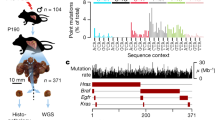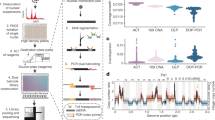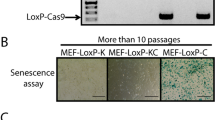Abstract
THE ability of mammalian cells to form colonies following suspension in semisolid agar, termed ‘anchorage independence’, is a phenotypic characteristic associated with cells transformed by oncogenic viruses and chemical carcinogens1–5. Because this phenotypic characteristic has been correlated with tumorigenicity2–5, colony formation in semisolid agar is used frequently as a quantitative in vitro assay for neoplastic transformation, especially in studies in Syrian hamster cell systems4,5. It is therefore important to understand the molecular and physiological basis of this phenotype. If the expression of this phenotype can be altered by somatic mutation of identifiable genes, information can be gained concerning the mechanism of anchorage-independent growth in vitro and its exact relationship to tumorigenicity and malignancy in vivo. We have investigated the ability of cells of the highly tumorigenic Syrian hamster fibroblast line, BP6T (ref. 9) to form colonies when suspended in semisolid agar. Cells of this line produce fibrosarcomas in 100% of newborn Syrian hamster inoculated with ten cells. In addition to anchorage-independent growth, BP6T cells also exhibit other in vitro characteristics of neoplastic transformed cell lines, such as increased plating efficiency in liquid medium at low cell densities, and enhanced fibrinolytic activity9. In this communication, we report that the ability of this Syrian hamster line to form colonies in semisolid agar is dependent on its utilisation of exogenous purines by way of the hypoxanthine phosphoribosyltransferase (HPRT, E.C.2.4.2.8.)- and adenine phos-phoribosyltransferase (APRT, E.C.2.4.2.7.)-mediated salvage pathways. Furthermore, this anchorage-independent property can be inhibited by a somatic mutation at the HPRT locus.
This is a preview of subscription content, access via your institution
Access options
Subscribe to this journal
Receive 51 print issues and online access
$199.00 per year
only $3.90 per issue
Buy this article
- Purchase on Springer Link
- Instant access to full article PDF
Prices may be subject to local taxes which are calculated during checkout
Similar content being viewed by others
References
MacPherson, I. & Montagnier, L. Virology 23, 291–294 (1964).
Freedman, V. H. & Shin, S. Cell 3, 355–359 (1974).
diMayorca, G., Greenblatt, M., Tranthen, T., Soller, A. & Giordano, R. Proc. natn. Acad. Sci. U.S.A. 70, 46–49 (1973).
Bouck, N. & diMayorca, G. Nature 264, 722–727 (1976).
Kakunaga, T. & Kamahora, J. Biken's J. 11, 313–332 (1968).
Montagnier, L. C. r. hebd. Séanc. Acad. Sci., Paris, Serie D. 268, 2218–2221 (1969).
Clarke, G. D. & Smith, C. J. Cell Physiol. 81, 125–132 (1972).
Taylor, J. C., Hill, D. W. & Rogolsky, M. Expl Cell Res. 90, 468–471 (1975).
Barrett, J. C., Crawford, B. & Ts'o, P. O. P. Cancer Res. 37, 1182–1185 (1977).
Sharp, J. D., Cappechi, N. E. & Cappechi, M. R. Proc. natn. Acad. Sci. U.S.A. 70, 3145–3149 (1973).
Szybalski, W., Szybalska, E. H. & Ragni, G. Natn. Cancer Inst. Monogr. 7, 75–80 (1962).
Yamane, I. & Murakami, O. Biochem. biophys. Res. Commun. 45, 1431–1436 (1971).
Yamane, I. & Murakami, O. J. Cell Physiol. 81, 281–284 (1973).
Miyashita, K. & Kakunaga, T. Cell 5, 131–138 (1975).
Vogel, A. & Pollack, R. Methods in Cell Biology 8 (ed. Prescott, D. M.) 75–92 (Academic, New York, 1974).
Author information
Authors and Affiliations
Rights and permissions
About this article
Cite this article
LEAVITT, J., CRAWFORD, B., BARRETT, J. et al. Regulation of requirements for anchorage-independent growth of Syrian hamster fibroblasts by somatic mutation. Nature 269, 63–65 (1977). https://doi.org/10.1038/269063a0
Received:
Accepted:
Issue Date:
DOI: https://doi.org/10.1038/269063a0
This article is cited by
-
Two classes of continuous cell lines established from Syrian hamster 9 day gestation embryos: Preneoplastic cells and progenitor cells
In Vitro Cellular & Developmental Biology (1990)
-
Comparison of the colony forming ability and invasive potential of six primate cell lines treated with retinoic acid
Investigational New Drugs (1986)
-
An improved soft agar method for determining neoplastic transformation in vitro
Journal of Tissue Culture Methods (1983)
-
Butyric acid suppression of the in vitro neoplastic state of Syrian hamster cells
Nature (1978)
-
Neoplastic transformation induced by a direct perturbation of DNA
Nature (1978)
Comments
By submitting a comment you agree to abide by our Terms and Community Guidelines. If you find something abusive or that does not comply with our terms or guidelines please flag it as inappropriate.



